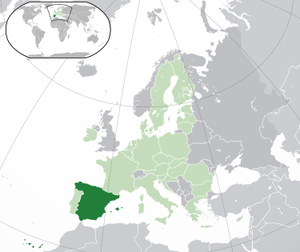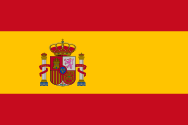Spain
| Kingdom of Spain+ |
|
(and Spain's largest city) |
Source information is available at [ Sources ] |
Spain (Spanish: España), formally the Kingdom of Spain is a country in Southwestern Europe with some pockets of territory in the Mediterranean Sea, offshore in the Atlantic Ocean, and across the Strait of Gibraltar. Its continental European territory is situated on the Iberian Peninsula, and its insular territory includes the Balearic Islands in the Mediterranean Sea, several small islands in the Alboran Sea, and the Canary Islands in the Atlantic Ocean. The Spanish territory also includes the African semi-exclaves of Ceuta, Melilla, and Peñon de Vélez across the Strait of Gibraltar. The country's mainland is bordered to the south and east by the Mediterranean Sea; to the north by France, Andorra and the Bay of Biscay; and to the west by Portugal and the Atlantic Ocean.
With an area of 505,990 km2 (195,360 sq mi), Spain is the largest country in Southern Europe, the second-largest country in Western Europe and the European Union, and the fourth-largest country by area on the European continent. With a population exceeding 47.3 million, Spain is the sixth-most populous country in Europe and the fourth-most populous country in the European Union. Spain's capital and largest city is Madrid; other major urban areas include Barcelona, Valencia, Seville, Zaragoza, Málaga, Murcia, Palma de Mallorca, Las Palmas de Gran Canaria and Bilbao.
History
Anatomically, modern humans first arrived in the Iberian Peninsula around 42,000 years ago. The first cultures and peoples that developed in current Spanish territory were Pre-Roman peoples such as the ancient Iberians, Celts, Celtiberians, Vascones, Turdetani, and Occitans. Later, foreign Mediterranean peoples, such as the Phoenicians and ancient Greeks, developed coastal trading colonies, and the Carthaginians briefly controlled part of the Spanish Mediterranean coastline. From the year 218 BC, with the taking of the city of Ampurias, the Roman colonization of Hispania began, and, except for the Atlantic cornice, they quickly controlled the territory of present-day Spain. The Romans had driven the Carthaginians out of the Iberian peninsula by 206 BC and divided it into two administrative provinces, Hispania Ulterior and Hispania Citerior. The Romans laid the foundations for modern Spanish culture and identity and were the birthplace of important Roman emperors such as Trajan, Hadrian, or Theodosius I.
Spain remained under Roman rule until the collapse of the Western Roman Empire in the fourth century, which ushered in Germanic tribal confederations from Central and Northern Europe. During this period, present-day Spain was divided between different Germanic powers, including the Suevi, Alans, Vandals, and Visigoths, the latter maintaining an alliance with Rome via foedus[Note 1], while part of Southern Spain belonged to the Byzantine Empire. Eventually, the Visigoths emerged as the dominant faction by the fifth century, with the Visigothic Kingdom spanning the vast majority of the Iberian Peninsula and establishing its capital in Toledo. The creation of the code of laws Liber Iudiciorum by King Recceswinth during the Visigothic period profoundly influenced Spain's structural and legal bases and the survival of Roman Law after the fall of the Roman Empire.
In the early eighth century, the Umayyad Caliphate invaded the Visigothic Kingdom, ushering in over 700 years of Muslim rule in Southern Iberia. During this period, Al-Andalus became a major economic and intellectual center, with the city of Córdoba being among the largest and richest in Europe. Several Christian kingdoms emerged in the northern periphery of Iberia, chief among them León, Castile, Aragón, Portugal, and Navarre. Over the next seven centuries, an intermittent southward expansion of these kingdoms— historically framed as a reconquest or Reconquista—culminated with the Christian seizure of the last Muslim polity, the Nasrid Kingdom of Granada, and the control of all Iberia by the Christian kingdoms in 1492. That same year, Christopher Columbus arrived in the New World on behalf of the Catholic Monarchs, whose dynastic union of the Crown of Castile and the Crown of Aragon is usually considered emergent Spain as a unified country. During the centuries after the Reconquista, the Christian kings of Spain persecuted and expelled ethnic and religious minorities such as Jews and Muslims through the Spanish Inquisition.
From the 16th until the early 19th century, Spain ruled one of the largest empires in history, among the first global empires; its immense cultural and linguistic legacy includes over 570 million Hispanophones, making Spanish the world's second-most spoken native language. Spain hosts the world's third-largest number of UNESCO World Heritage Sites.
Spanking in Spain

In the 20th century, school corporal punishment fell out of fashion and was gradually banned in many countries, a trend that continues until the present day.
As of May 2008, Spain prohibits corporal punishment in schools.
Spanish culture traditionally endorsed corporal punishment and used it in judicial decrees and, in milder forms, on children in parenting and education.
The painting to the left, by one of Spain's most famous artists, shows a school corporal punishment scene that might be characteristic of how the same was administered in 18th century Spanish schools. One student, with his bottom bared, is horsed by another student to be whipped by the teacher, who remains seated during the chastisement. On the right, two other students who have already been punished are crying.
Spanish spanking art
A Spanish BDSM and spanking artist is Arantza. Alejandro Colucci, illustrator for Spanking Tails and Spanking Tails 2, was born in Uruguay to a family of Italian immigrants but lives in Spain since 2002.
A Spanish film director who received international admiration for her short films on the subject of child fear, humiliation, and punishment is Isabel Ayguavives.
Spanking videos
- A Spanking in Spain (PunishmentsOnly), Ana L., photos
- Caned at the Hell Hotel (Spanking Sarah, 2020), F/F, filmed in Spain
- Captured in Spain (Spanking Sarah, 2024), Essie Quinn, Alora Lux, Sarah Stern, photos
- Held Captive in Spain 1 (Spanking Sarah), photos
- Held Captive in Spain 2 (Spanking Sarah), photos
- Held Captive in Spain 3 (Spanking Sarah), photos
- Held Captive in Spain 4 (Spanking Sarah), photos
- The Hell Hotel, Part 2 - I Got Caught (Spanking Sarah), photos
- Liz Rainbow is Back for Discipline (Real Life Spankings), Spanish model Liz Rainbow, photos
- Love and Lust in Spain (Spanking Sarah, 2024), Alora Lux, Essie Quinn, strap-on dildo, photos
- Megan & The Pool Cleaner (Spanking Sarah, c. 2019), filmed in Spain, photos
- Not So Fun in The Sun (Triple A Spanking), Sarah Gregory, Zoe Page, swimming pool, filmed in Spain, photos
- Olga Cabaeva From Spain Joins RLS (Real Life Spankings), photos
- Olga Cabeava From Spain Returns To RLS and Gets Soundly Disciplined (Real Life Spankings, 2019), photos
- Olga Cabeava Gets Soundly Punished for Peeing in the Woods (Real Life Spankings), urination, photos
- Olga Misses Discipline (Real Life Spankings), Olga Cabaeva, photos
- Paddle For a Senior Girl (Spanking Sarah), filmed in Spain, photos
- The Pain in Spain (Elite Spanking), photos
- The Pain in Spain (Zoe Page Video), Sarah Gregory, photos
- Spanked in Spain (Spanking Sarah, 2017), swimming pool, photos
- The Spanking Cook Book, The BBQ (English Spankers), Mr. Stern, filmed in Spain, photos
- Spanking in Spain (Dreams of Spanking), photos
- The SUI Badminton Club, Episode 20: Punished In The Woods (Spanked In Uniform), Olga Cabaeva, outdoor spanking (photos)
- Top To Bottom (Zoe Page Video), Sarah Gregory, filmed in Spain, photos
- Unladylike Manor: Episode 50 - Hideaway in Spain (Spanking Sarah), photos
- Unladylike Manor: Episode 52: Caned in Spain (Spanking Sarah), Mr. Stern, Sarah Stern, Suzanne Smart (photos)
Prostitution in Spain
- Prostitution in Spain ↗ on Wikipedia
Sources
Notes
- ↑ Foederati were peoples and cities bound by a treaty, known as foedus, with Rome. During the Roman Republic, the term identified the socii. Still, during the Roman Empire, it was used to describe foreign states, client kingdoms or barbarian tribes to which the empire provided benefits in exchange for military assistance.
External links
- More information is available at [ Wikipedia:Spain ]
Chat rooms • What links here • Copyright info • Contact information • Category:Root

